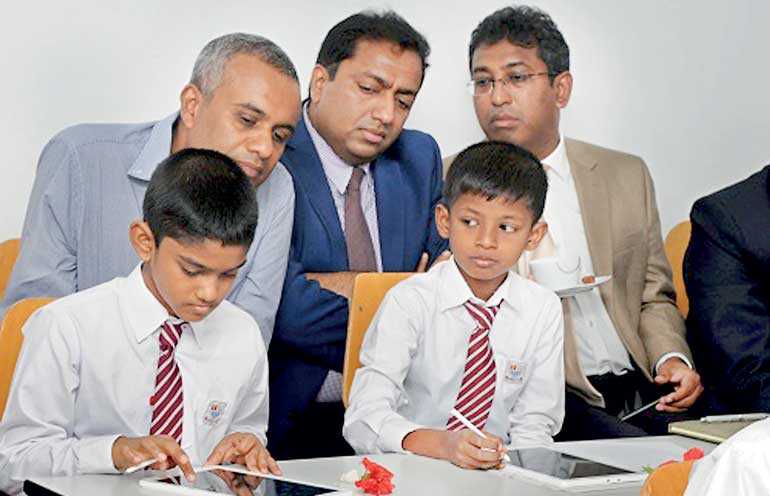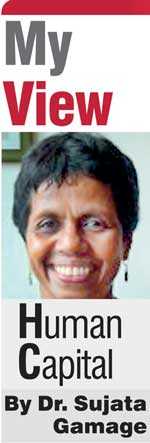Tuesday Apr 15, 2025
Tuesday Apr 15, 2025
Tuesday, 10 July 2018 00:27 - - {{hitsCtrl.values.hits}}

The first step in digital literacy is access. In a good practices study of ICT use in schools we found that teachers, principals and parents use a variety of methods from a strict ‘no-no’ to ‘guided-use’ of the internet for their children. A first step would be to seek more good practices, compile a menu of those and allow schools to select what they find most appropriate
‘Tabs for A/L students’ and ’13 years of education for all’ are two promises from the 2015 election manifesto of the UNP. Both are game-changer promises, but a promise in a manifesto is only a starting point. Bureaucrats have to expand the ideas as policies and implement.
A policy document on 13 years of education was shared widely early this year at an event held at the National Institute of Education. As for the tabs concept we are yet to see a policy document that goes beyond the size, shape, and of course the details of the all-important procurement of the devices. Missing is a discussion on expected educational outcomes and ways to assess.
Concerns about harm and cost are legitimate
The President has raised the issue of unsavoury uses of tabs by youth and the cost of the program. Those are legitimate concerns. Use of any technology brings with it positive or negative implications. The decision to use or not use depends on the weight of the net benefits, and the steps to be taken to reduce the harms, if any.
In that respect, the ball is now in the Ministry’s court. The Ministry has the responsibility to detail the benefits of the tabs, beyond simplistic claims that the ‘tabs will facilitate students’ studies’. Essentially, the Ministry has to be explicit about what it expects to achieve by giving a free tab to each student in the 2019 incoming class of Grade 12 in the public schools, at a cost of five billion or more per year.
Pilot or full rollout dilemma
The President wants the Ministry conduct a pilot tab program first, but, the Ministry is in a hurry to deliver on its promises before the next election. A compromise solution would be to limit the tabs initially to new vocational education (A/L) stream while spelling out the expected learning outcomes for that program and committing to file an evaluation report.
Such an approach should be acceptable as a pilot to the President’s office since only a limited number of tabs need to be provided and an evaluation report will follow. For the UNP it would be essentially a full rollout of the Tabs in its other key initiative of introducing a vocational education stream to keep more children in school for 13 years.
Why limit tabs to the vocational stream?
The vocational education stream is a new avenue for students completing year 11 but not qualifying for the more academic GCE (Advanced Level) classes offered in year 12 and 13. This new avenue will enable 150,000 or more students who drop out at year 11 or before, to complete 13 years of education in a school setting, though not all are expected to enrol in the initial stages.
At its consultation meeting, NIE presented the proposed vocational curriculum which included six general subjects, followed by 26 specialties from which students could choose. There were many concerns about the details of the program, but overall there was consensus that the vocational education stream should be given every opportunity to succeed.
According to a ministry press release dated 29 January, vocational stream was piloted in 49 National schools in 2017 in Phase I of the project. In 2018 in Phase II, the pilot was extended to 150 Provincial schools with classes. For a full rollout of the program in 2019, or Phase III, the ministry expects to recruit 40,000 new teachers. It is a tall order. As the Ministry spokesperson noted, there may be some difficulty on finding properly qualified teachers for all the new subjects. As noted earlier, the enrolment of students too would not at full capacity initially.
I had the opportunity to visit one of the classes in a Phase I School. The students had completed the set of six general subjects. By that time only about 50% of the original group was attending the program, but those attending were enthusiastic. Two were happy that they were able continue with the sports programs in the school as a result of the new vocational stream. Two others were registered for a course at the German Tech and were wondering how to continue with that as well.
Of the six general subjects covered so far the business English course was their favourite followed by IT. In other subjects especially Sinhala they felt it was the same old same old. One shared with me the report he did on Otara Gunawardana for his entrepreneurship class. It was written by hand. If a typed up report was a requirement, he would have learned his IT at the same time, I felt.
They all wanted better it facilities with internet connection. They all access the internet through mobile phones, their own or parents’. Although I cannot make generalisations after talking to one class of students, their desire to have better access to ICT and opportunities to use ICT was very strong.
The students entering the new vocational stream are ideal candidates for free tabs, in my opinion. It is difficult to integrate IT tools into the GCE (A/L) curriculum right away, because it is packed with facts to be explained by teacher or tuition master. IT is easier to integrate IT in the vocational stream where the curriculum is still evolving. Students can be required to do much searching, screening, assessing and synthesising information from the Internet on their own using the tabs.
Solution 2: Use as opportunity for digital literacy
In its Global Framework of Reference on Digital Literacy Skills for Indicator 4.4.2 of sustainable development goals, UNESCO defines digital literacy as the “ability to access, manage, understand, integrate, communicate, evaluate and [synthesise] information safely and appropriately through digital technologies for employment, decent jobs and entrepreneurship. It includes competences that are variously referred to as computer literacy, ICT literacy, information literacy and media literacy”.
Note that the first step in digital literacy is access. In a good practices study of ICT use in schools we found that teachers, principals and parents use a variety of methods from a strict ‘no-no’ to ‘guided-use’ of the internet for their children. A first step would be to seek more good practices, compile a menu of those and allow schools to select what they find most appropriate.
A method to assess digital literacy is needed next. The list of tasks that are part of the definition of digital literacy provides a guide I believe. For example, all student assignments can be graded for indications of digital literacy they demonstrate along the Search-Screen-Assess-Synthesis tasks. Such assignments of course should be first given to the teacher in charge to assess his/her own digital literacy.
Discover Kapruka, the leading online shopping platform in Sri Lanka, where you can conveniently send Gifts and Flowers to your loved ones for any event including Valentine ’s Day. Explore a wide range of popular Shopping Categories on Kapruka, including Toys, Groceries, Electronics, Birthday Cakes, Fruits, Chocolates, Flower Bouquets, Clothing, Watches, Lingerie, Gift Sets and Jewellery. Also if you’re interested in selling with Kapruka, Partner Central by Kapruka is the best solution to start with. Moreover, through Kapruka Global Shop, you can also enjoy the convenience of purchasing products from renowned platforms like Amazon and eBay and have them delivered to Sri Lanka.
Discover Kapruka, the leading online shopping platform in Sri Lanka, where you can conveniently send Gifts and Flowers to your loved ones for any event including Valentine ’s Day. Explore a wide range of popular Shopping Categories on Kapruka, including Toys, Groceries, Electronics, Birthday Cakes, Fruits, Chocolates, Flower Bouquets, Clothing, Watches, Lingerie, Gift Sets and Jewellery. Also if you’re interested in selling with Kapruka, Partner Central by Kapruka is the best solution to start with. Moreover, through Kapruka Global Shop, you can also enjoy the convenience of purchasing products from renowned platforms like Amazon and eBay and have them delivered to Sri Lanka.